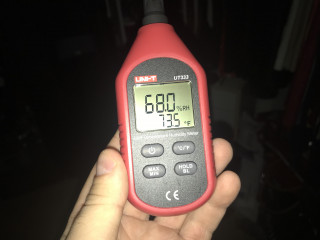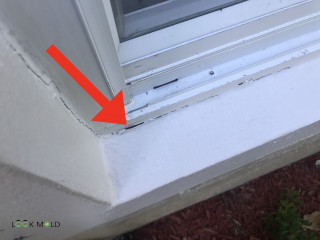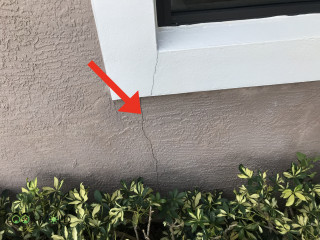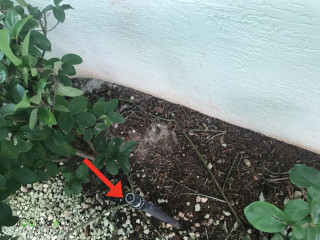Having mold on baseboards in the house can be an eyesore, but does it indicate a more significant problem is present?
It can!
Baseboards are often overlooked as they mostly serve the purpose of covering the area between the floor and the wall.
But if you learn a few simple secrets and pay attention, your baseboards can talk to you and let you know about water intrusion issues in the home.
So, get ready to learn what you need to know in regards to mold in the baseboards.
What Causes Mold To Grow On Baseboards

The main cause of mold to grow on baseboards is just like any other materials, water.
Whether it's due to water intrusion from the outside envelope of the home, a plumbing or other leak, or just water in the air (humidity), mold can start to colonize on baseboards.
What matters most is:
Is it superficial mold Or active mold growth?
Superficial mold, also referred to as surface mold or mildew, can easily be cleaned off baseboards compared to active mold growth where the baseboard will need to be removed.
The cause of surface mold will, in most cases, will be related to high relative humidity.
Mold is found in just about every single indoor environment. Mold spores love dark, moist places, which is why you will often find mold on the surface of baseboards in rooms that do not get much natural lighting. The sun contains UV rays that can help inhibit mold growth.
Superficial mold on baseboards can come in different colors, such as:
*Tip: It may be hard to see white mold on white baseboards. An easier way to see it, is to stand to the side and shine a flashlight on the baseboard horizontally__
Active mold growth on the baseboards is caused by water damage relating to a leak. This type of mold will appear to be growing through the baseboard. It will not be quite as powdery and appear more as if the baseboard was drawn on with a crayon. If the mold is slimy, it likely indicates the area is actively wet, and there will be mold growth behind the baseboard.
Active mold in baseboards will appear in different colors, but more than often will be black or green.
Just because the mold is black does not automatically mean it's black toxic mold.
How To Clean Mold On Baseboards
To remove surface mold on baseboards, household cleaners such as white distilled vinegar can be used effectively. However, it is important to note that mold found behind baseboards should be handled by a professional. Self-cleaning efforts can potentially worsen the issue and the mold could indicate a deeper problem.

Superficial mold on baseboards can usually be cleaned in a few simple steps, before getting rid of the mildew, the cause will need to be corrected, which we already established as humidity.
Correction of high moisture in the air of a home can be corrected in as easy as running your air conditioning more often. If you have central air conditioning, it should be built to pull moisture properly.
If your air conditioning is not dehumidifying correctly, it could mean it's not balanced or sized correctly. If this is the case, a licensed HVAC professional should be consulted with.
A quick fix could be installing an external dehumidification system.
Once you have the humidity under control, you should gather the following items needed to remove mold off the surface of baseboards:
• A mild detergent or biodegradable mold spray • A cloth or paper towel •
Wet the rag with the solution and the surface mold should come right off.
It's that easy.
Removing Mold On Baseboards Due To Water Damage

Removing mold on baseboards where a leak or flood occur may seem simple. In many cases, the mold will come off easier than the superficial mold.
It would be best if you did not clean the area with bleach or any other chemical. When active mold growth is present, there is a good chance the mold is present behind the baseboards and inside of the walls.
Mold tends to grow behind the baseboards because the baseboards on top of the drywall don't allow the walls to breathe or get light, which causes it to retain water.
Without a mechanical drying method in place, such as a dehumidifier, walls can stay wet for a long time.
Staying wet for a long duration can allow Stachybotrys, which is the real name for black mold and other types of mold that can produce mycotoxins to grow behind baseboards.
Extensive water damage should exclusively be removed by a mold remediation professional. If you are unsure whether to remove the mold yourself or have a pro, you can refer to our mold remediation guide.
Preventing Mold From Growing On Baseboards
To prevent mold from growing on baseboards, moisture will need to be controlled. You will need to be a detective of some sort.
Here are a few steps you can ensure mold will not grow in the baseboards:
Keep Humidity Low  You now know your air conditioning may not have been functioning properly if it's not controlling humidity.
You now know your air conditioning may not have been functioning properly if it's not controlling humidity.
Get yourself a tool that measures humidity, and you want to make sure the number stays below 60-65%.
Caulk Your Windows  Window caulking deteriorates over time, which allows little cracks where water can enter. Water flows down when it goes inside the wall, so you may not even notice anything for a while, causing water damage behind baseboards.
Window caulking deteriorates over time, which allows little cracks where water can enter. Water flows down when it goes inside the wall, so you may not even notice anything for a while, causing water damage behind baseboards.
Caulking your windows every couple of years can prevent this from occurring.
Painting The Exterior Of Your Home  People tend to think painting a home their favorite color is strictly to make it look good, but it was an actual purpose if you have a concrete block home.
People tend to think painting a home their favorite color is strictly to make it look good, but it was an actual purpose if you have a concrete block home.
Painting the home is crucial for waterproofing the home. Not painting the home for many years can cause cracking, which can allow water to wicker in the building envelope.
Moving Sprinklers Away From The Home 
When sprinklers are continually hitting the home, it can allow water to find it through the same little cracks in the concrete.
Ensure the sprinklers are a proper distance from the house is crucial.
Install Gutters Or Other Drainage System  Wherever your home is located, one goal you want to accomplish is to push water away from home. This is especially true if you have a basement.
Wherever your home is located, one goal you want to accomplish is to push water away from home. This is especially true if you have a basement.
Gutters or other drainages like French drains can help push water away from home.
Moldy Baseboards And Your Health
While surface mold itself on baseboards is usually harmless, it could mean you have mold spores present on porous items such as carpeting, furniture or other building materials.
These types of mold spores can cause allergic reactions, such as a stuffy nose or sinus issues.
The mold that is growing on your baseboards due to water damage is another story.
This type of mold can off-gas, which can lead to further health issues and should not be taken lightly!

Meet the author: Brad Fishbein is an ACAC council-certified Microbial Investigator. In the fall of 2012, he became a Licensed Mold Assessor in the State of Florida through the Department of Business & Professional Regulation. Brad has helped homeowners with over 5,000 successfully completed Mold Inspections since 2009.

